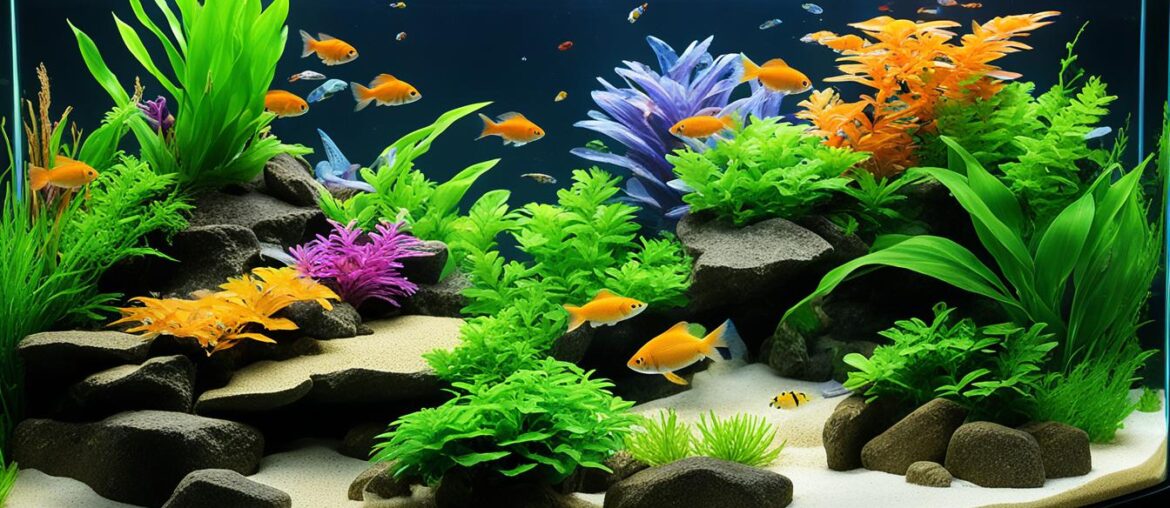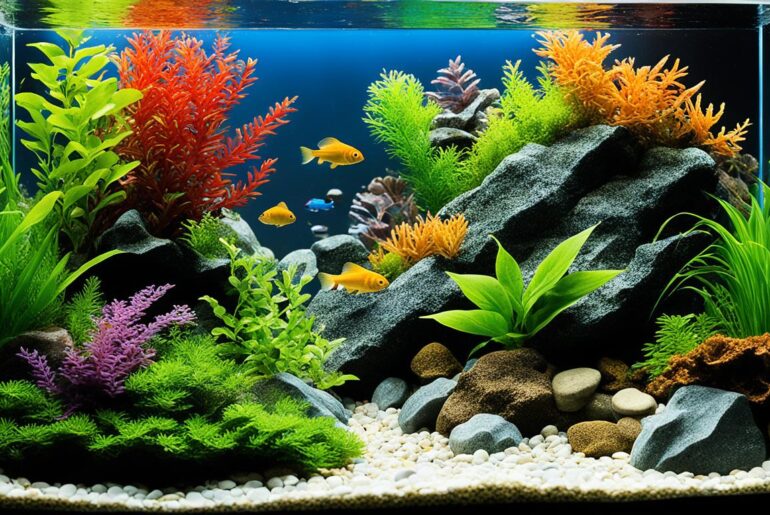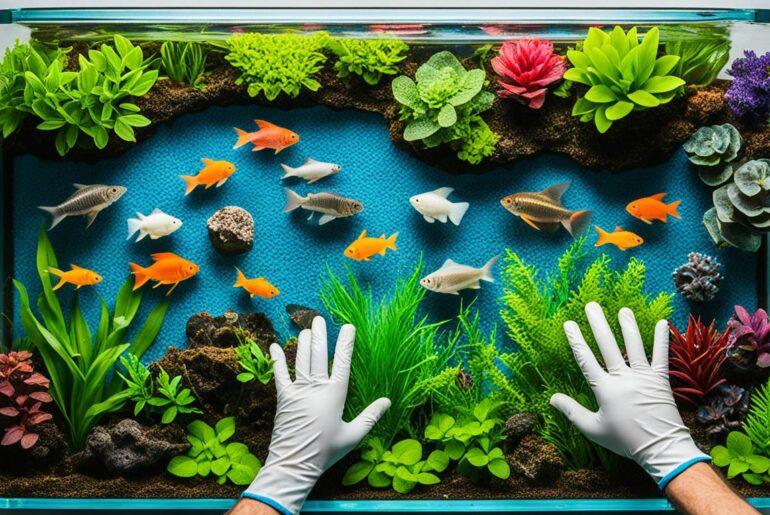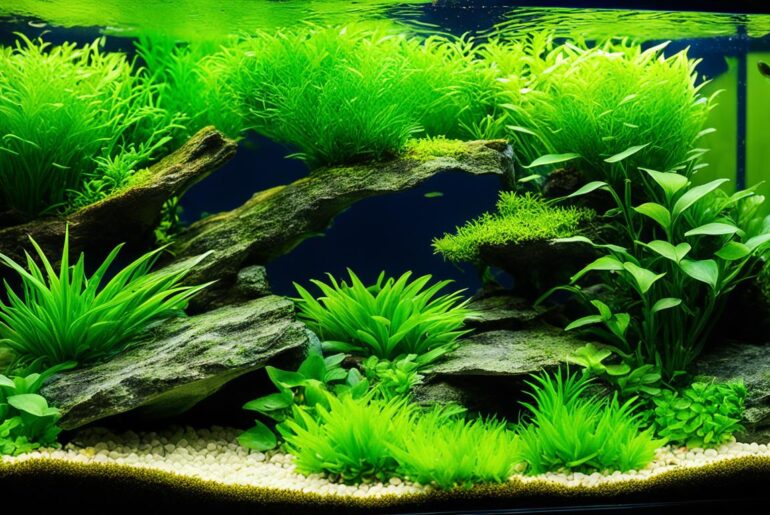Imagine stepping into a room filled with vibrant colors, gentle swaying plants, and a sense of tranquility that instantly washes over you. That’s the feeling I get every time I gaze into my freshwater tank, a carefully curated underwater oasis that brings me joy and a deep connection to nature.
But it wasn’t always this way. When I first started my freshwater tank journey, I struggled to create an environment that thrived. My fish seemed stressed, my plants struggled to grow, and my water quality was far from ideal.
That’s when I discovered the incredible benefits of active substrates. These substrates revolutionized my freshwater tank and transformed it into a thriving ecosystem that exceeded my expectations. In this guide, I will share with you the wonders of active substrates and how they can elevate your freshwater tank experience to new heights.
Key Takeaways:
- Active substrates promote the health of fish and stimulate the growth of aquatic plants.
- These substrates release beneficial nutrients and support the biological processes in the tank.
- They contribute to maintaining water quality and creating a balanced and thriving ecosystem.
- Choosing the right active substrate is crucial for maximizing the benefits in your freshwater tank.
- Proper installation and maintenance of active substrates are key to their effectiveness.
The Importance of Substrate in Freshwater Tanks
The substrate in a freshwater tank serves as more than just a decorative element. It plays a crucial role in creating a healthy environment for the fish.
Active substrates provide a range of benefits that are essential for maintaining fish health and overall tank well-being. These substrates are specially designed to release essential nutrients into the water, promoting optimal fish health and supporting the growth of aquatic plants.
One of the primary benefits of active substrates is the release of nutrients. Unlike inert substrates, active substrates consist of nutrient-rich materials that provide the necessary elements for plant and fish growth.
“Active substrates play a crucial role in fostering a healthy and thriving aquarium environment.”
These nutrients, such as iron, potassium, and trace elements, are vital for the proper development of fish and the vibrant growth of aquatic plants. Beneficial bacteria also thrive in active substrates, contributing to a balanced nitrogen cycle and reducing the risk of ammonia spikes.
An optimal substrate for freshwater tanks helps to maintain a stable pH level and improve water quality. It acts as a buffer, preventing dramatic fluctuations in pH and providing a more stable environment for fish. Additionally, active substrates help to reduce the buildup of harmful substances, such as nitrites and nitrates, which can be detrimental to fish health.
Benefits of Active Substrates for Fish Health:
- Release of essential nutrients
- Promotion of beneficial bacteria growth
- Maintenance of stable pH levels
- Improvement of water quality
| Benefits | Explanation |
|---|---|
| Essential Nutrients | Active substrates release essential nutrients such as iron, potassium, and trace elements, supporting fish health and plant growth. |
| Beneficial Bacteria Growth | Active substrates promote the growth of beneficial bacteria, which plays a crucial role in maintaining a healthy nitrogen cycle and reducing the risk of ammonia spikes. |
| Stable pH Levels | Active substrates help maintain a stable pH level, preventing drastic fluctuations and creating a more suitable environment for fish. |
| Improved Water Quality | Active substrates contribute to improving water quality in the tank by reducing the buildup of harmful substances, such as nitrites and nitrates. |
Promoting Fish Health with Active Substrates
Active substrates in freshwater tanks are essential for enhancing the health and well-being of fish. By releasing vital nutrients and providing a favorable environment, these substrates play a crucial role in supporting fish growth and development. Additionally, active substrates promote the growth of beneficial bacteria and help maintain a healthy nitrogen cycle, reducing ammonia spikes and providing a stable ecosystem for the fish.
One of the key benefits of active substrates for fish health is the release of essential nutrients such as iron, potassium, and trace elements. These nutrients are crucial for the proper growth and development of fish, supporting functions like metabolism, immune system function, and reproductive health. With active substrates, fish have continuous access to these nutrients, ensuring their overall health and vitality.
“Active substrates create a thriving environment that promotes excellent fish health and vitality.” – Aquarium Enthusiast Magazine
Active substrates also contribute to the growth of beneficial bacteria. These bacteria play a vital role in maintaining water quality by breaking down harmful substances like ammonia and nitrites, which can be toxic to fish. By promoting the growth of these beneficial bacteria, active substrates help create a stable nitrogen cycle and reduce the risk of ammonia spikes, ensuring a healthier and safer environment for the fish.
When fish are provided with a favorable environment, their stress levels decrease, leading to improved overall health. Active substrates contribute to a well-balanced ecosystem that supports fish well-being, reducing the risk of diseases and promoting their natural behaviors. By mimicking natural habitats, active substrates create a sense of security for fish, encouraging them to explore and thrive.
| Benefits of Active Substrates for Fish Health |
|---|
| Enhanced growth and development due to the release of essential nutrients |
| Promotion of beneficial bacteria growth and a healthy nitrogen cycle |
| Reduction of stress levels in fish, leading to improved overall health and vitality |
| Creation of a stable ecosystem that supports natural fish behaviors |
Overall, active substrates are a valuable addition to any freshwater tank, providing numerous benefits for fish health. By releasing essential nutrients and supporting the growth of beneficial bacteria, these substrates create a thriving environment that promotes excellent fish health and vitality.
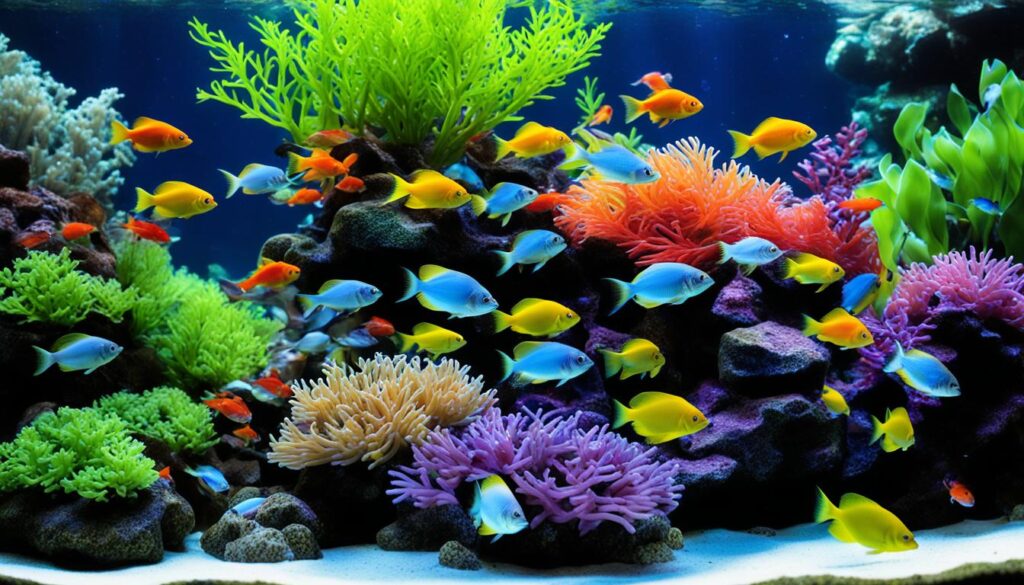
Enhancing Aquatic Plant Growth with Active Substrates
Active substrates play a crucial role in promoting the growth of aquatic plants in freshwater tanks. These substrates provide several benefits that contribute to the overall health and aesthetics of the tank. By releasing essential nutrients and providing a stable substrate for plant roots, active substrates create an ideal environment for aquatic plants to thrive.
One of the key benefits of active substrates for aquatic plants is the release of essential nutrients such as nitrogen, phosphorus, and potassium. These nutrients are vital for the growth and development of plants. By providing a steady supply of these nutrients, active substrates ensure that aquatic plants have access to the elements they need to grow lush and vibrant.
Aquatic plants also require a stable and secure substrate to anchor their roots. Active substrates provide a solid base for plants to establish themselves and absorb nutrients and water effectively. This stability allows the plants to develop strong root systems, ensuring optimal uptake of essential resources.
By creating an ideal growing environment, active substrates enhance the overall aesthetics of the freshwater tank. Lush and vibrant plants not only add beauty to the tank but also provide additional benefits for the fish. Aquatic plants help maintain water quality by absorbing excess nutrients and producing oxygen through photosynthesis. They also offer shelter and hiding places for fish, reducing stress and promoting natural behavior.
Maintaining Water Quality and a Balanced Ecosystem
One of the key benefits of using active substrates in freshwater tanks is the positive impact they have on maintaining water quality and creating a balanced ecosystem. These substrates play a vital role in the biological filtration process, working in tandem with beneficial bacteria to break down harmful substances such as ammonia and nitrites. This not only helps prevent water pollution but also reduces the risk of fish stress and disease.
By promoting the growth of beneficial bacteria, active substrates contribute to a healthier and more stable aquatic environment. These bacteria aid in the breakdown of organic matter, preventing the accumulation of harmful substances that can negatively impact fish health. Additionally, the presence of beneficial bacteria helps to establish and maintain a natural nitrogen cycle, ensuring the efficient conversion of ammonia into less toxic compounds.
Active substrates also support the growth of beneficial microorganisms, such as fungi and algae. These microorganisms further enhance the ecosystem by providing additional filtration and contributing to the overall balance of the tank. Fungi help break down organic waste, while algae absorb excess nutrients, reducing the risk of algae overgrowth and improving water clarity.
The combination of beneficial bacteria, fungi, and algae creates a harmonious and self-sustaining ecosystem within the freshwater tank. This balanced ecosystem helps maintain water quality, enhances the overall well-being of the fish, and supports the growth of aquatic plants. The interplay between these components ensures that the tank remains healthy and stable, reducing the need for frequent interventions or corrective measures.
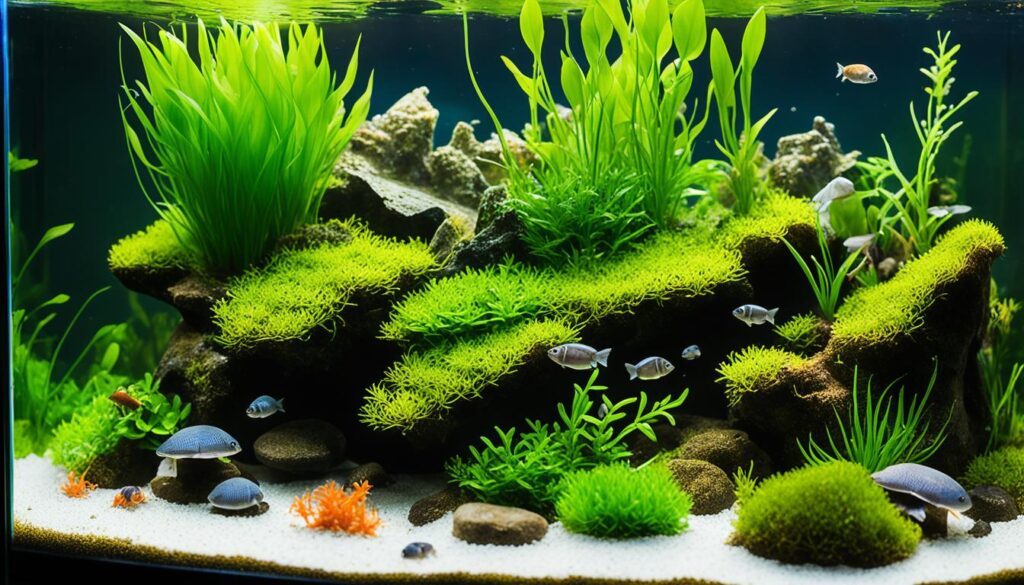
Overall, the benefits of active substrates in freshwater tanks extend beyond aesthetics. These substrates actively contribute to maintaining water quality and creating a balanced ecosystem, promoting the health and well-being of both the fish and the overall aquatic environment. By harnessing the power of beneficial bacteria and microorganisms, active substrates play a crucial role in fostering a thriving and vibrant freshwater tank.
Choosing the Right Active Substrate
Selecting the optimal substrate for your freshwater tank is essential to maximize the benefits it provides. Various factors should be taken into consideration to ensure the substrate meets the specific needs of your aquarium ecosystem. These factors include the type of fish and plants in the tank, desired pH and water hardness levels, and aesthetic preferences.
Active substrates come in different forms, such as nutrient-rich soil, clay, or sand, each offering unique advantages. Nutrient-rich soil, for example, provides a natural source of essential nutrients for plants and supports their growth. Clay substrates are known for their ability to retain moisture and can benefit plants that require a stable water environment. Meanwhile, sand substrates are suitable for fish species that prefer burrowing and creating natural habitats.
When choosing an active substrate, consider the specific requirements and preferences of your fish and plants. Research the natural habitats of your species and consider replicating the substrate type found in those environments. This will help create a familiar and comfortable setting for your aquatic organisms.
Ideally, the active substrate you choose should provide the necessary nutrients for both fish and plant health, support beneficial bacteria growth, and contribute to maintaining water quality. By carefully selecting the right substrate for your freshwater tank, you can create an environment that promotes the well-being and vitality of your fish and plants.
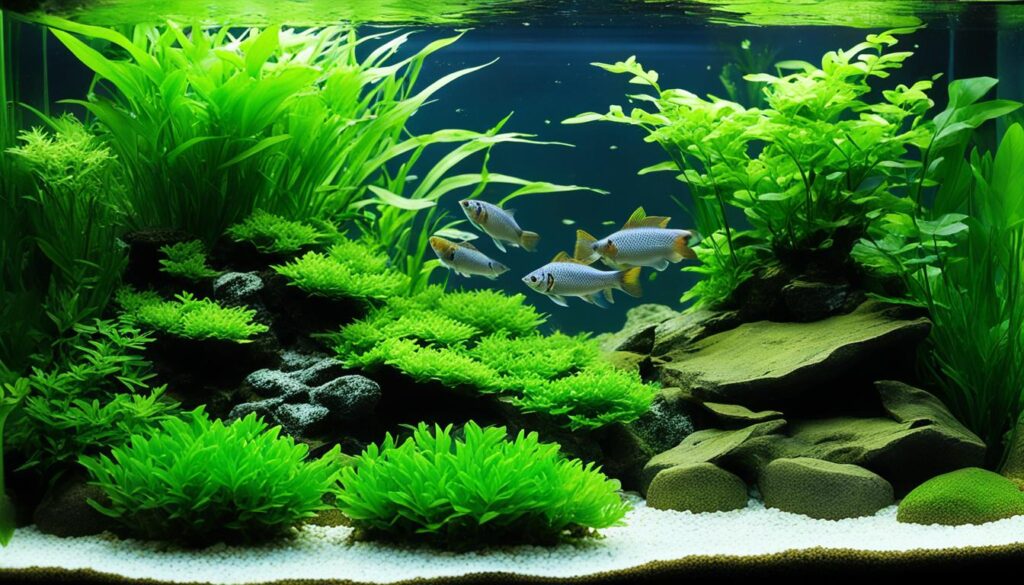
Comparing Different Active Substrates
| Substrate Type | Advantages |
|---|---|
| Nutrient-Rich Soil |
|
| Clay |
|
| Sand |
|
Choosing the Ideal Substrate
Each substrate type offers unique benefits, so the ideal choice depends on the specific needs of your tank.
For tanks with a focus on lush plant growth, nutrient-rich soil is often the preferred choice. It provides a rich source of nutrients for plants, ensuring they receive the essential elements necessary for healthy development.
If you’re looking to create a stable water environment or have fish species that require sandy substrates for burrowing, clay or sand substrates would be more suitable options. These substrates provide the desired characteristics and create natural habitats for your fish.
Ultimately, your choice of active substrate should be based on a thorough understanding of your tank’s requirements, including the fish and plants you intend to keep. By selecting the right substrate, you can provide the optimal conditions for your aquatic organisms, establishing a thriving and visually appealing freshwater tank.
Proper Installation and Maintenance of Active Substrates
Installing and maintaining active substrates in freshwater tanks is crucial to ensure the optimal benefits they provide. Proper care and attention during the installation process will lay the foundation for a healthy and thriving aquarium ecosystem.
Before adding the active substrate, it is essential to clean the tank thoroughly and ensure that it is free from any detergents or contaminants. Any residue left in the tank can negatively impact the water quality and the overall well-being of the fish and plants.
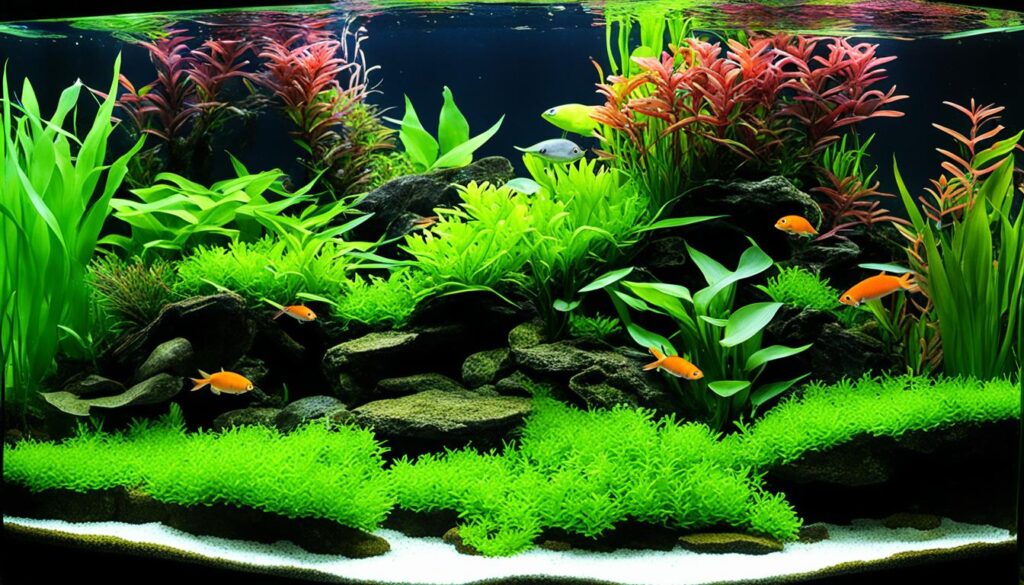
Create a Stable Base for Plants and Fish
Once the tank is clean and ready, evenly spread the active substrate across the bottom of the tank. This will create a stable and supportive base for the aquatic plants and fish. A well-distributed layer of substrate will also help to prevent any uneven growth or instability within the tank.
Routine Maintenance for Water Quality
Maintaining water quality is crucial for the health and longevity of the fish and plants. Regular water changes and substrate vacuuming are necessary to remove any debris or waste that may accumulate over time. This will help prevent the build-up of harmful substances and ensure a clean and balanced environment.
Monitoring Nutrient Levels
Active substrates release beneficial nutrients into the water, providing essential nourishment for the plants and fish. It is important to monitor the nutrient levels regularly and adjust fertilization accordingly. This will prevent over or underdosing and ensure that the plants and fish receive the optimal amount of nutrients for their growth and well-being.
| Installation and Maintenance Tips | Actions |
|---|---|
| Thoroughly clean the tank | Remove any detergents or contaminants |
| Evenly spread the substrate | Create a stable base for plants and fish |
| Perform regular water changes | Maintain water quality and remove debris |
| Vacuum the substrate | Prevent the build-up of waste |
| Monitor nutrient levels | Adjust fertilization to prevent under or overdosing |
Proper installation and maintenance of active substrates will contribute to the overall success and benefits of your freshwater tank. By following these guidelines, you can create a thriving and visually appealing aquarium that promotes the health of the fish and plants, while maintaining a balanced ecosystem.
Troubleshooting and Problem Solving
While active substrates offer numerous benefits, it’s important to address any challenges or issues that may arise in your freshwater tank. One common problem is excessive nutrient release from the substrate, which can lead to algae overgrowth. To combat this, I recommend making a few adjustments:
- Adjust the lighting levels: Algae thrive in bright light, so reducing the intensity or duration of light exposure can help control their growth.
- Implement regular water changes: Changing a portion of the water frequently can help dilute excess nutrients and prevent algae from taking over.
- Fine-tune fertilization: If you use additional fertilizers, ensure you’re not overusing them. Follow the instructions carefully and only provide the necessary nutrients for your plants.
Additionally, some fish may have specific substrate preferences. For example, there are species that prefer sandy substrates for burrowing. It’s crucial to research the specific needs of your fish and provide them with a suitable environment to thrive.
By being proactive and addressing potential problems in your freshwater tank, you can ensure a successful and harmonious aquarium ecosystem.
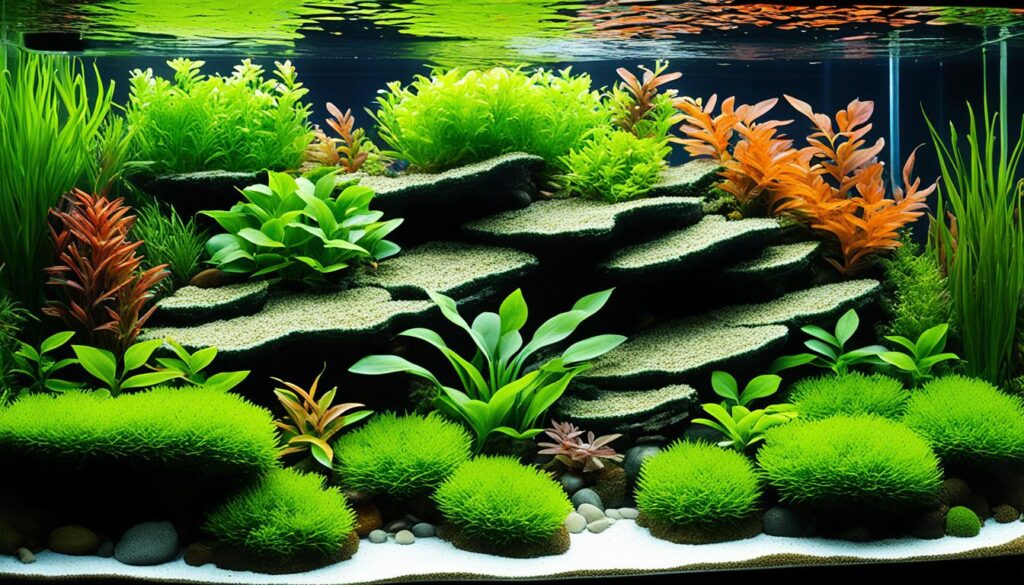
Conclusion
Active substrates in freshwater tanks offer a plethora of benefits that enhance the overall ecosystem and provide a thriving environment for fish and plants. These substrates play a crucial role in maintaining water quality, promoting fish health, and boosting plant growth. By selecting the right substrate, properly installing and maintaining it, and addressing any troubleshooting or problem-solving issues, aquarium enthusiasts can create a visually pleasing and healthy freshwater tank.
The benefits of active substrates include the release of essential nutrients into the water, which support the growth and development of fish and aquatic plants. These substrates also foster the growth of beneficial bacteria, which help maintain a stable nitrogen cycle and prevent water pollution. Additionally, active substrates contribute to a balanced ecosystem by supporting the growth of beneficial microorganisms.
When choosing an active substrate, consider the specific needs of the tank, such as the type of fish and plants, desired pH levels, and aesthetic preferences. Proper installation and maintenance, including regular cleaning and water changes, are essential to ensure the longevity of the substrate and prevent any unforeseen issues. By harnessing the benefits of active substrates, aquarium enthusiasts can create a beautiful and thriving freshwater tank that benefits both their aquatic inhabitants and the overall ecosystem.
FAQ
What are the benefits of using active substrates in freshwater tanks?
Active substrates provide essential nutrients, promote beneficial bacteria growth, improve water quality, and contribute to the overall well-being of fish and the ecosystem.
How do active substrates promote fish health?
Active substrates release essential nutrients and promote the growth of beneficial bacteria, which results in improved growth, lower stress levels, and overall better health for fish.
What advantages do active substrates offer for aquatic plant growth?
Active substrates release essential nutrients, provide a stable substrate for root anchoring, and create an ideal growing environment for lush and vibrant aquatic plant growth.
How do active substrates help maintain water quality and create a balanced ecosystem?
Active substrates promote the growth of beneficial bacteria, which helps in the biological filtration process and reduces the risk of pollution, stress, and disease in fish. They also support the growth of beneficial microorganisms, contributing to a healthy and balanced ecosystem.
What should I consider when choosing the right active substrate for my freshwater tank?
Factors to consider include the type of fish and plants, desired pH and water hardness levels, and aesthetic preferences. Different forms of active substrates, such as nutrient-rich soil, clay, or sand, offer various advantages.
How should I install and maintain active substrates in my freshwater tank?
Thoroughly clean the tank before adding the substrate, evenly spread it across the bottom, and perform routine maintenance such as water changes and substrate vacuuming to prevent debris accumulation and maintain water quality.
Are there any troubleshooting or problem-solving techniques for active substrates in freshwater tanks?
Yes, techniques such as adjusting lighting levels, implementing regular water changes, and fine-tuning fertilization can address issues like algae overgrowth or specific substrate requirements for certain fish species.
